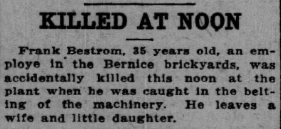
The British steamer Roddam narrowly escaped the catastrophic volcanic eruption in Martinique on May 8, 1902. Covered in volcanic ash, the ship and its crew faced a scene of devastation after the eruption of Mount Pelée, which destroyed the town of St. Pierre. According to Captain Cantell of the Etona, who encountered the Roddam at St. Lucia on May 11, the ship was coated in two feet of hot ash, causing fires and severe injuries to the crew, some of whom had their limbs burned off by the falling debris.
Scene of Ruin is Deplorable

The Norton steamer Etona arrived today from the river Plate by St. Lucia, where she called for a bunker of coal on May 2.
“At St. Lucia on May 11,” says Captain Cantell, “I went on board the British steamer Roddam, which had escaped from the terrible volcanic eruption at Martinique three days before. The Roddam was covered with a mass of fine blueish-grey dust or ashes of cement-like appearance. In some parts it lay two feet deep on the decks. This matter had fallen in a red hot state all over the steamer, setting fire to everything it struck that was burnable, and when it fell on the men on board, burned off limbs and large pieces of flesh. This was shown by finding portions of human remains when the decks were cleared of the debris. The rigging, ropes, tarpaulins, sails, awnings, etc., were charred or burned and most of the upper stanchions and spars had been swept overboard or destroyed by fire. Skylights were smashed and cabins were filled with volcanic dust. The scene of ruin was deplorable.”
Captain’s Account
“I visited the captain of the Roddam in the hospital at St. Lucia where he gave me an account of his terrible experience. He had just arrived and anchored at St. Pierre, Martinique, on the morning of Thursday, May 8. The captain was standing near the accommodation ladder talking to the agent of the vessel, who had come on board, when he saw what appeared to be an enormous black cloud, like a wall with patches of fire in it, approaching the sea from the land. With it came an immense tidal wave of boiling water accompanied by a loud and terrible noise. He shouted ‘take shelter’ to the crew. Immediately the steamer was caught and tossed over on her side, almost capsizing. Darkness fell and volumes of red hot matter showered down while the air was thick with sulfurous fumes and dust. The sea was a confused mass of boiling mud.
“Fire soon broke out in different parts of the ship. Screams, groans, and cries of agony from the injured people mingled with the terrible noise of boiling water and rushing air, together with the falling fire, caused a most horrible confusion and frightful din.
“The captain of the Roddam, knowing that his ship had steam up, and instantly realizing the necessity of escape, rushed to the engine room annunciator and signaled below to start the engine at full speed. The anxious moment, increased by his sufferings from burns and agony of mind, was relieved by the vibration of the engines and the reply from below.”
Engineers Nearby
“It happened, fortunately, that although the crew had been running off from duty at the engines, some of the engineers which had swept over the Roddam and nearly capsized her had parted the cable and the vessel was adrift. When the engines started it was found that the steering gear had become disabled in some manner, and could not be worked. For more than an hour the Roddam’s engines were worked, backing and going ahead, with the hope of bringing her head toward the sea and away from the land. Once she got dangerously near to the steamer Roraima. Both vessels were in flames. Some of those aboard jumped into the boiling water; some fell dying to the deck. All this time the red hot matter was falling and the water was hissing and steaming dense masses of vapor. Smoke and dust filled the air and poisoned fumes spread about.
“After some time the Roddam’s steering gear moved a little and enabled the captain to head her out to sea, and, with considerable difficulty, he managed to steer her a little distance from the land. As the air cleared the scene on board the ill-fated Roddam became all the more ghastly. The ship steamed through the hot dust and the screams became more audible.
Some rushed frantically about with their clothes on fire and large piece of flesh burned from their arms; others in their agony lay writhing in the red hot dust.
“In about two hours the air became gradually clear. An investigation of the casualties on board showed that besides the captain, who was frightfully injured, only two engineers, two sailors, and the boatswain were able to do duty.”
Rigging in Flames
“Fire was still burning about the ship and the rigging was in flames. The captain decided to try to reach the island of St. Lucia 45 miles distant. This he succeeded in doing by 6 o’clock on the evening of May 8. The steamer was difficult to handle owing to the partially disabled steering gear which could not be made to work properly. In the time occupied on this terrible voyage the experience of the survivors was still worse than that already gone through. The brave captain and his few men fighting the fire, exhausted and scalded, struggled and worked trying to do something to assist their dying shipmates. Those working below strived to keep up the steam. The captain, suffering the greatest agony, succeeded in navigating his vessel safely to the port of Castries, St. Lucia with 18 dead bodies lying on the deck and human limbs scattered about. Sailors stood by constantly wiping the captain’s injured eyes. I think the performance of the Roddam’s captain was most wonderful, and the more so when I saw his pitiful condition. I do not understand how he kept up; yes, when the steamer arrived at St. Lucia and medical assistance was procured, this brave man asked the doctors to attend to the others first and refused to be treated until this was done.
“My interview with the captain brought out this account.”
Formation of Island Changed
“The Etona sailed from St. Lucia on the morning of May 11 and at 2 o’clock in the afternoon passed the Island of Martinique. The formation of the island is quite altered and the whole northern part where the town of St. Pierre once stood is covered with a mass of ashes and lava. At about 2:30 as the Etona was passing the island, a tremendous upshoot of smoke and dust took place and in a few moments the ship was covered with fine dust like cement. We were about three miles distant from the island at the time. The ship’s engines were put under full speed and for a time considerable anxiety was felt on board. For an hour or two the ship was covered with dust and enveloped in a thick cloud and the air was filled with sulphur fumes. It must have been another eruption and the dust must have been sent a great distance in the air because it traveled against the wind and at a tremendous rate of speed.”
Source: The age-herald. (Birmingham, Ala.), 19 May 1902.

